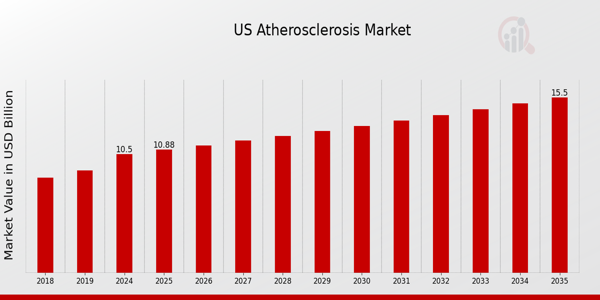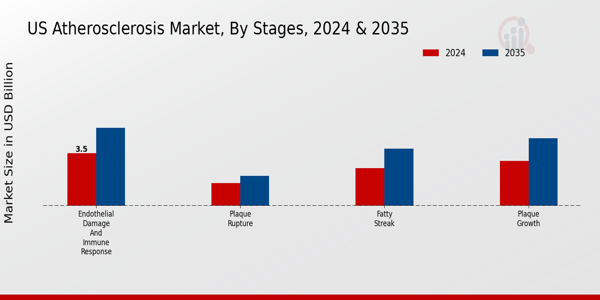US Atherosclerosis Market Overview
As per MRFR analysis, the US Atherosclerosis Market Size was estimated at 9.95 (USD Billion) in 2023. The US Atherosclerosis Market Industry is expected to grow from 10.5 (USD Billion) in 2024 to 15.5 (USD Billion) by 2035.
The US Atherosclerosis Market CAGR (growth rate) is expected to be around 3.604% during the forecast period (2025 - 2035).
Key US Atherosclerosis Market Trends Highlighted
The US Atherosclerosis Market has undergone noteworthy changes in the recent past due to the increasing occurrence of cardiovascular diseases. Cases of atherosclerosis are rising due to an aging population, lifestyle choices, and increasing rates of obesity. Improving heart health and cholesterol management awareness promoted by the Centers for Disease Control and Prevention (CDC) is empowering patients which result in more people seeking preventive care and treatment.
This shift towards prevention is increasing the need for new therapeutic products aimed at improving cholesterol and cardiovascular health. This market can be served more effectively with the use of new technologies, individualization, and personalized medicine. There is a focus on developing new therapies for specific patients which includes genetic profiling and other precision medicine approaches.
In addition to this, the growth of telemedicine and other digital health solutions during and after the COVID-19 pandemic allows easier consultation with healthcare providers which leads to better monitoring and adherence to treatment regimens. These strategies enable companies to better differentiate themselves by offering more tailored products. Recent trends have shown that even greater attention is being given to lifestyle treatment methods, like exercise and eating regimens, in the management of atherosclerosis.
Public health initiatives sponsored by government institutions motivate patients to improve their health habits, alongside the growing popularity of plant-rich diets and exercise programs. This method serves not only to tackle the condition at hand, but also enhances general health, subsequently driving the demand for goods and services in the US Atherosclerosis Market.

US Atherosclerosis Market Drivers
Increasing Prevalence of Atherosclerosis in the US Population
The US Atherosclerosis Market Industry is significantly driven by the rising prevalence of atherosclerosis among the population. As per the Center for Disease Control and Prevention (CDC), nearly 20% of adults aged 65 and older are diagnosed with heart disease, which includes atherosclerosis, translating into approximately 7 million affected individuals in the US. With the aging population and lifestyle changes, such as poor diet, lack of exercise, and obesity, this figure is projected to increase.
The National Institutes of Health (NIH) also underscores that the incidence of atherosclerotic cardiovascular disease is expected to rise due to demographic shifts and health trends. The growing number of individuals affected by atherosclerosis necessitates enhanced medical intervention and innovative treatment options, thus enhancing growth prospects within the US Atherosclerosis Market.
Advancements in Medical Technologies for Atherosclerosis Treatment
Innovations in medical technology are a key driver for the US Atherosclerosis Market Industry. The adoption of minimally invasive procedures and advanced diagnostic tools contributes to better patient outcomes. For instance, the Food and Drug Administration (FDA) has approved several cutting-edge devices and therapies over the past few years. According to a report from the American College of Cardiology (ACC), there has been a notable increase in the use of catheter-based interventions, which have improved the management of atherosclerosis conditions.
Such advancements foster growth as healthcare providers seek effective solutions to treat atherosclerosis while ensuring patient comfort and satisfaction.
Growing Awareness and Education about Cardiovascular Diseases
The increasing awareness and education surrounding cardiovascular diseases and atherosclerosis significantly impact the US Atherosclerosis Market Industry. The American Heart Association (AHA) has implemented numerous campaigns aimed at educating the public about heart health and the importance of managing risk factors such as cholesterol and blood pressure. According to the AHA, approximately 85.6 million Americans live with some form of cardiovascular disease, which has heightened the urgency for preventive measures.
Enhanced public knowledge can lead to early detection and treatment, ultimately driving the demand for atherosclerosis-related therapeutics and solutions in the US.
Government Initiatives and Funding for Atherosclerosis Research
Government initiatives focused on the research and development of treatments for atherosclerosis serve as a crucial driver in the US Atherosclerosis Market Industry. The National Heart, Lung, and Blood Institute (NHLBI) provides substantial funding aimed at advancing atherosclerosis research and improving therapeutic options. In 2022 alone, the NHLBI invested millions into research programs targeting the understanding and treatment of cardiovascular diseases, including atherosclerosis.
This financial support enables the development of new pharmacological agents, interventions, and clinical trials, thereby enhancing treatment options and market growth potential in the US.
US Atherosclerosis Market Segment Insights
Atherosclerosis Market Stages Insights
The US Atherosclerosis Market has seen a nuanced segmentation concerning the different stages of the disease, each of which plays a pivotal role in determining health outcomes. The stages include Endothelial Damage and Immune Response, Fatty Streak, Plaque Growth, and Plaque Rupture, each contributing uniquely to the progression of atherosclerosis. Endothelial Damage and Immune Response marks the initial stage where the endothelium of blood vessels is compromised, often due to factors such as high cholesterol levels and inflammation.
This stage is crucial as it sets the foundation for subsequent developments. Fatty Streak follows as a response to the initial damage, highlighting the infiltration of lipids into the arterial walls and indicates early signs of atherosclerosis. It is essential to note that this stage is typically reversible if addressed with lifestyle changes. The third stage, Plaque Growth, signifies a more advanced development characterized by the accumulation of cells, lipids, and debris, which can threaten blood flow.
This stage often leads to cardiovascular diseases if not monitored or treated. Lastly, Plaque Rupture is a critical event that can precipitate acute clinical events like heart attacks or strokes, making it a focal point of therapeutic intervention. The importance of accurately identifying and managing these stages cannot be overstated as it directly correlates with improved patient outcomes and long-term management strategies.
Trends in the US indicate a growing awareness and proactive approach to atherosclerosis, driven largely by escalating rates of cardiovascular diseases. Furthermore, healthcare professionals are increasingly focusing on preventative measures and early diagnoses that target each of these stages, which is likely to shape future treatment protocols. As the population ages and lifestyle-related risk factors increase, the emphasis on understanding these stages and their implications within the framework of the US Atherosclerosis Market remains significant.
In summary, the stage-wise breakdown highlights vital areas for research and development efforts, as well as substantial opportunities for innovative therapies to mitigate the impact of atherosclerosis on public health. By understanding the pathophysiology inherent to each stage, stakeholders in the US Atherosclerosis Market can enhance their strategic focus, ultimately seeking to achieve better health outcomes and reduce the burden of cardiovascular diseases on the healthcare system.

Atherosclerosis Market Diagnosis Insights
The Diagnosis segment of the US Atherosclerosis Market plays a pivotal role in the early detection and management of cardiovascular diseases, significantly impacting patient outcomes. Techniques like Ankle-brachial Index (ABI) and Doppler Ultrasound serve as vital non-invasive methodologies for assessing blood flow and arterial function, proving essential for preventative care strategies. The Echocardiogram and Electrocardiogram (ECG) are instrumental in evaluating heart functionality, allowing for timely interventions that can drastically alter disease progression.
Moreover, Blood Tests are crucial for identifying lipid profiles and inflammatory markers, enabling a comprehensive approach to risk assessment. Each diagnostic tool contributes uniquely to the broader landscape of cardiovascular health, with growing adoption driven by technological advancements and increased awareness of heart disease prevalence in the US. With rising healthcare initiatives focusing on preventive care, these diagnostic methods stand as cornerstones in managing atherosclerosis, ensuring continuous monitoring and timely treatment for affected individuals. Enhanced diagnostic accuracy and accessibility are further expected to stimulate market growth, reflecting the importance of these techniques in the healthcare ecosystem.
Atherosclerosis Market Treatment Insights
The Treatment segment within the US Atherosclerosis Market focuses on addressing the challenges posed by this cardiovascular condition, which has significant implications for public health. With the market projected to experience steady growth, it encompasses various therapeutic approaches, predominantly Medication and Surgery. Medication is crucial as it establishes first-line defenses against lipid levels and inflammation, ensuring many patients manage their conditions effectively through lifestyle modifications combined with pharmaceutical interventions.
Meanwhile, Surgery plays a vital role for patients with advanced atherosclerosis, offering procedural options that can restore adequate blood flow and significantly reduce the risk of severe events like heart attacks. With the increasing prevalence of obesity and sedentary lifestyles in the US, the demand for both treatment modalities is likely to expand. Furthermore, healthcare reforms and advancements in medical technologies continue to drive growth in this sector, presenting opportunities for innovation in drug formulations and surgical techniques. Overall, the Treatment segment remains a vital component in the fight against atherosclerosis, contributing to improved outcomes and quality of life for patients across the country.
Atherosclerosis Market End-User Insights
The End-User segment of the US Atherosclerosis Market encompasses diverse healthcare settings where treatment and management of atherosclerosis take place. Hospitals dominate this segment, serving as primary facilities for acute care, advanced diagnostics, and specialized procedures, ensuring that patients receive timely intervention for cardiovascular conditions. Specialty Clinics also play a significant role, focusing on personalized treatment plans and preventive care tailored to individuals with atherosclerosis, thereby addressing specific patient needs effectively.
The Homecare sector is emerging as an important area, offering patients convenience and support in managing their condition within the comfort of their homes, which is increasingly favored by both patients and their families due to its potential for improved quality of life. Other settings related to patient care also contribute to the overall service framework, reflecting the various approaches taken to manage atherosclerosis effectively. Market growth in this segment is driven by factors such as the rising prevalence of cardiovascular diseases, growing awareness of preventive healthcare, and advancements in treatment methodologies, presenting various opportunities for healthcare providers to innovate and improve patient outcomes. Additionally, challenges such as the need for efficient resource allocation and patient education remain pivotal in shaping future strategies in the management of atherosclerosis across these varied end-user settings.
US Atherosclerosis Market Key Players and Competitive Insights
The US Atherosclerosis Market is characterized by a dynamic landscape where multiple players strive to gain a competitive edge by focusing on innovative solutions and advanced treatment options. This market is influenced by a rising prevalence of cardiovascular diseases, increasing awareness among healthcare providers regarding the importance of early diagnosis and management, and a growing emphasis on preventive healthcare measures. The competition in this sector spans several fronts, including the development of novel therapeutics, collaborations for research and development, and strategic marketing efforts to reach healthcare professionals and patients effectively. As stakeholders in the healthcare ecosystem seek to enhance patient outcomes and reduce the burden of atherosclerosis, the strategies employed by market players shape a continuously evolving competitive scenario.
AstraZeneca has established a notable presence in the US Atherosclerosis Market, leveraging its strengths in research and development to innovate within the cardiovascular therapeutic segment. The company has invested significantly in clinical trials and partnerships, ensuring a robust pipeline of products that cater to various stages of atherosclerosis management. Its comprehensive approach towards patient care, supported by a focus on precision medicine, allows AstraZeneca to differentiate itself from other competitors. With a long-standing commitment to advancing cardiovascular treatments, this company benefits from a wide distribution network and strong brand recognition that enhances its positioning and accessibility in the US healthcare landscape.
Takeda, a prominent player in the US Atherosclerosis Market, has established its foothold through a focus on delivering therapeutic solutions that align with unmet medical needs among patients affected by cardiovascular diseases. The company emphasizes its proprietary medications that target lipid management and associated risk factors, contributing to improved patient outcomes. With an active approach to mergers and acquisitions, Takeda has expanded its portfolio by incorporating cutting-edge therapies and strengthening its market presence. The company’s focus on innovative research, combined with strategic collaborations and alliances, amplifies its capabilities to drive growth in this competitive landscape. By prioritizing patient health and safety, Takeda effectively aligns its goals with healthcare providers and patients, making a positive impact in the realm of atherosclerosis management.
Key Companies in the US Atherosclerosis Market Include
- Regeneron Pharmaceuticals
US Atherosclerosis Market Industry Developments
Recent developments in the US Atherosclerosis Market reveal significant advancements and competitive dynamics among major pharmaceutical companies such as AstraZeneca, Takeda, Merck, and Bristol Myers Squibb. In particular, AstraZeneca has made strides with its cardiovascular drug pipeline, targeting therapies that address inflammation linked to atherosclerosis. Meanwhile, Merck recently announced progress in its clinical trials for new atherosclerosis treatments, aiming to provide more effective options for patients.
Current market affairs include a notable increase in the valuation of several companies involved in Atherosclerosis treatment, attributed to heightened investment in Research and Development and a growing focus on preventative therapies. Additionally, among the notable merger and acquisition activities, in June 2023, Pfizer completed its acquisition of a biotech firm focused on cardiovascular drugs, indicating strategic consolidation within the sector.
Over the past few years, the market has seen heightened regulatory focus and scientific advancements, including a landmark approval in November 2022 for a new lipid-lowering therapy. Sanofi and Regeneron Pharmaceuticals continue to innovate with their cholesterol-lowering treatments, reflecting the increasing market competitiveness and focusing on reducing cardiovascular risks among the US population.
Atherosclerosis Market Segmentation Insights
Atherosclerosis Market Stages Outlook
- Endothelial Damage and Immune Response
Atherosclerosis Market Diagnosis Outlook
- Ankle-brachial Index (ABI)
Atherosclerosis Market Treatment Outlook
Atherosclerosis Market End-User Outlook
| Report Attribute/Metric |
Details |
| Market Size 2023 |
9.95(USD Billion) |
| Market Size 2024 |
10.5(USD Billion) |
| Market Size 2035 |
15.5(USD Billion) |
| Compound Annual Growth Rate (CAGR) |
3.604% (2025 - 2035) |
| Report Coverage |
Revenue Forecast, Competitive Landscape, Growth Factors, and Trends |
| Base Year |
2024 |
| Market Forecast Period |
2025 - 2035 |
| Historical Data |
2019 - 2024 |
| Market Forecast Units |
USD Billion |
| Key Companies Profiled |
AstraZeneca, Takeda, Merck, Janssen Pharmaceuticals, Amgen, GSK, Bristol Myers Squibb, Sanofi, Regeneron Pharmaceuticals, Boehringer Ingelheim, AbbVie, Novartis, Pfizer, Eli Lilly and Company |
| Segments Covered |
Stages, Diagnosis, Treatment, End-User |
| Key Market Opportunities |
Innovative drug development, Personalized medicine approaches, Advanced diagnostic technologies, Telehealth for management, Lifestyle intervention programs |
| Key Market Dynamics |
rising prevalence of cardiovascular diseases, increasing geriatric population, advances in diagnostic technologies, growth in lifestyle-related risk factors, enhanced treatment options and therapies |
| Countries Covered |
US |
Frequently Asked Questions (FAQ):
The US Atherosclerosis market is projected to be valued at 10.5 billion USD in 2024.
By 2035, the US Atherosclerosis market is expected to reach a value of 15.5 billion USD.
The compound annual growth rate (CAGR) for the US Atherosclerosis market is expected to be 3.604% from 2025 to 2035.
In 2024, the Endothelial Damage and Immune Response stage holds the highest market value at 3.5 billion USD.
The Plaque Growth stage is valued at 3.0 billion USD in the US Atherosclerosis market in 2024.
Some major players include AstraZeneca, Merck, Amgen, and Pfizer, among others.
The market value for the Fatty Streak stage is expected to reach 3.8 billion USD by 2035.
The Plaque Rupture stage is projected to have a market value of 2.0 billion USD by 2035.
Increasing prevalence of atherosclerosis-related diseases and advancements in treatment options are key growth drivers.
Challenges include high treatment costs and regulatory hurdles affecting market access.















